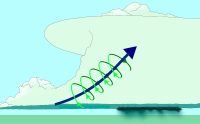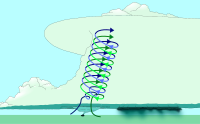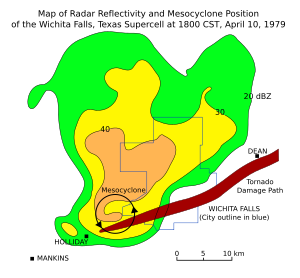משתמש:אביעד/פרויקט המטאורולוגיה
דף זה נועד כדי לאסוף ערכים בנושא מטאורולוגיה שלא קיימים או לא מורחבים מספיק. כך, אט אט למחוקם מן הרשימה.
היסטוריה של המטאורולוגיה- חיזוי מזג האוויר
- אובך
- רוח אוכלת שלג
- מזג האוויר
פסי התעבות- אקלים טרופי
- אקלים ממוזג
- אקלים סובטרופי
- משקעים
מונחים[עריכת קוד מקור | עריכה]
- אוויר בלתי יציב
- אובך
- אוזון
- אוכף (מטאורולוגיה)
- אופטימום אקלימי
- אוקלוזיה - מפגש חזיתי הנוצא כתוצאה מכך חזית קרה משיגה חזית חמה.
- אורורה
- איזובר
- איזוהיפסה
מבנה תא-העל[עריכת קוד מקור | עריכה]
המודל הרעיוני הנוכחי של תא-העל תואר בספר "התפתחות סופות חמורות ומבנה המזוציקלון מבנה רעמי אבולוציה הקשורים בהיווצרות טורנדו" (Severe Thunderstorm Evolution and Mesocyclone Structure as Related to Tornadogenesis) מאת לסלי למון וצ'ארלס דוסוול. התנועה הסיבובית של תאי-העל נובעת מהטיית הערבוליות האופקית (מערבולת אופקית בלתי נראית) הנגרמת מגזירת הרוח. משבים חזקים מעלים את האוויר המסתובב סביב הציר האופקי וגורמים לו לנוע סביב ציר אנכי. דבר זה גורם לזרם אנכי עמוק מסתובב - המזוציקלון.
על פי רוב, נדרשת אינוורסיית כיסוי כדי ליצור זרם אנכי עם כוח מספיק. הכיסוי הוא שכבה מהופכת (חם מעל קר) מעל שכבה נורמלית (קר מעל חם). מניעת אוויר חם מהקרקע לעלות מאפשרת יצירת אחד או שניים מהמצבים הבאים:
- האוויר מתחת לכיסוי מתחמם ו/או נהיה לח יותר.
- האוויר מעל לכיסוי מתקרר.
מצב זה יוצר שכבה חמה ולחמה יותר מתחת לשכבה קרה שאינה יציבה, כיוון שאוויר חם צפוף פחות ונוטה לעלות. כאשר הכיסוי נחלש או נע, מתרחשות התפתחויות פתאומיות ועוצמתיות.
בצפון אמריקה, תאי-על מופיעים במכ"ם דופלר בתחילתם כנקודה או כקרס בדרום-מערב, ונמשכים לעבר צפון-מזרח. המשקעים הכבדים ביותר הם בדרך כלל בצד הדרום מערבי, ומסתיימים בפתאומיות...
The current conceptual model of a supercell was described in Severe Thunderstorm Evolution and Mesocyclone Structure as Related to Tornadogenesis by Leslie R. Lemon and Charles A. Doswell III. (See Lemon technique).
Supercells derive their rotation through tilting of horizontal vorticity (an invisible horizontal vortex) caused by wind shear. Strong updrafts lift the air turning about a horizontal axis and cause this air to turn about a vertical axis. This forms the deep rotating updraft, the mesocyclone.
A cap or capping inversion is usually required to form an updraft of sufficient strength. The cap puts an inverted (warm-above-cold) layer above a normal (cold-above-warm) boundary layer, and by preventing warm surface air from rising, allows one or both of the following:
- Air below the cap warms and/or becomes more moist
- Air above the cap cools
This creates a warmer, moister layer below a cooler layer, which is increasingly unstable (because warm air is less dense and tends to rise). When the cap weakens or moves, explosive development follows.
In North America, supercells usually show up on Doppler radar as starting at a point or hook shape on the southwestern side, fanning out to the northeast. The heaviest precipitation is usually on the southwest side, ending abruptly short of the rain-free updraft base or main updraft (not visible to radar). The rear flank downdraft, or RFD, carries precipitation counterclockwise around the north and northwest side of the updraft base, producing a "hook echo" that indicates the presence of a mesocyclone.
 |
 |
 |
Structure of a supercell[עריכת קוד מקור | עריכה]


Overshooting top[עריכת קוד מקור | עריכה]
This "dome" feature appears above the strongest updraft location on the anvil of the storm. It is a result of a very powerful updraft; enough to break through the upper levels of the troposphere. An observer who is at ground level too close to the storm is unable to see the overshooting top due to the fact that the anvil blocks the sight of this feature.
Anvil[עריכת קוד מקור | עריכה]
An anvil forms when the storm's updraft collides with the upper levels of the lowest layer of the atmosphere, or the troposphere, and has nowhere else to go due to the laws of fluid dynamics- specifically pressure, humidity, and density. The anvil is very cold and virtually precipitation free even though virga can be seen falling from the forward sheared anvil. Since there is so little moisture in the anvil, winds can move freely. The clouds take on their anvil shape when the rising air reaches 15,200–21,300 מטרים (50,000–70,000 רגל) or more. The anvil's distinguishing feature is that it juts out in front of the storm like a shelf. In some cases, it can even shear backwards, called a backsheared anvil, another sign of a very strong updraft.
Precipitation-free base[עריכת קוד מקור | עריכה]
This area, typically on the southern side of the storm in North America, is relatively precipitation free. This is located beneath the main updraft, and is the main area of inflow. While no precipitation may be visible to an observer, large hail may be falling from this area. A region of this area is called the Vault. It is more accurately called the main updraft area.
Wall cloud[עריכת קוד מקור | עריכה]
The wall cloud forms near the downdraft/updraft interface. This "interface" is the area between the precipitation area and the precipitation-free base. Wall clouds form when rain-cooled air from the downdraft is pulled into the updraft. This wet, cold air quickly saturates as it is lifted by the updraft, forming a cloud that seems to "descend" from the precipitation-free base. Wall clouds are common and are not exclusive to supercells; only a small percentage actually produce a tornado, but if a storm does produce a tornado it usually exhibits wall clouds that persist for more than ten minutes. Wall clouds that seem to move violently up or down, and violent movements of cloud fragments (scud or fractus) near the wall cloud are indications that a tornado could form.
Mammatus clouds[עריכת קוד מקור | עריכה]
Mammatus (Mamma, Mammatocumulus) are bulbous or pillow-like cloud formations extending from beneath the anvil of a thunderstorm. These clouds form as cold air in the anvil region of a storm sinks into warmer air beneath it. Mammatus are most apparent when they are lit from one side or below and are therefore at their most impressive near sunset or shortly after sunrise when the sun is low in the sky. Mammatus are not exclusive to supercells and can be associated with developed thunderstorms and cumulonimbus.
Forward Flank Downdraft (FFD)[עריכת קוד מקור | עריכה]
This is generally the area of heaviest and most widespread precipitation. For most supercells, the precipitation core is bounded on its leading edge by a shelf cloud that results from rain-cooled air within the precipitation core spreading outward and interacting with warmer, moist air from outside of the cell. Between the precipitation-free base and the FFD, a "vaulted" or "cathedral" feature can be observed. In high precipitation supercells an area of heavy precipitation may occur beneath the main updraft area where the vault would alternately be observed with classic supercells.
Rear Flank Downdraft (RFD)[עריכת קוד מקור | עריכה]
תבנית:Main The RFD of a supercell is a very complex and not yet fully understood feature. RFD mainly occur within classic and HP supercells although RFDs have been observed within LP supercells. The RFD of a supercell is believed to play a large part in tornadogenesis by further tightening rotation within the surface mesocyclone. RFDs are caused by mid level steering winds of a supercell colliding with the updraft tower and moving around it in all directions; specifically the flow that is redirected downward is referred to as the RFD. This downward surge of relatively cool mid level air, due to interactions between dew points, humidity, and condensation of the converging of air masses, can reach very high speeds and is known to cause widespread wind damage. The radar signature of an RFD is a hook like structure where sinking air has brought with it precipitation.
Vault[עריכת קוד מקור | עריכה]
A vault is not observed with all supercells. The vault can only be identified visibly due to it visibly appearing to be free of precipitation but usually containing large hail. On Doppler radar, the region of very high precipitation echos with a very sharp gradient perpendicular to the RFD.
Flanking line[עריכת קוד מקור | עריכה]
A line of smaller cumulonimbi or cumulus that form in the warm rising air pulled in by the main updraft. Due to convergence and lifting along this line, landspouts sometimes occur on the outflow boundary of this region.
Radar features of a supercell[עריכת קוד מקור | עריכה]

- Hook echo or Pendant
The "hook echo" is the area of confluence between the main updraft and the rear flank downdraft (RFD). This indicates the position of the mesocyclone, and probably a tornado.
- Bounded weak echo region (or BWER)
This is a region of low radar reflectivity bounded above by an area of higher radar reflectivity with an untilted updraft. This is evidence of a strong updraft, and oftentimes the presence of a tornado.
- Inflow notch
A "notch" of weak reflectivity on the inflow side of the cell. This is not a V-Notch.
- V Notch
A "V" shaped notch on the leading edge of the cell, opening away from the main downdraft. This is an indication of divergent flow around a powerful updraft.
- Hail spike
This three body scatter spike is a region of weak echoes found radially behind the main reflectivity core at higher elevations when large hail is present.[1]
- ^ National Weather Service (ביוני 2009). "Hail spike". Glossary. National Oceanic and Atmospheric Administration. נבדק ב-2010-03-03.
{{cite web}}: (עזרה)
